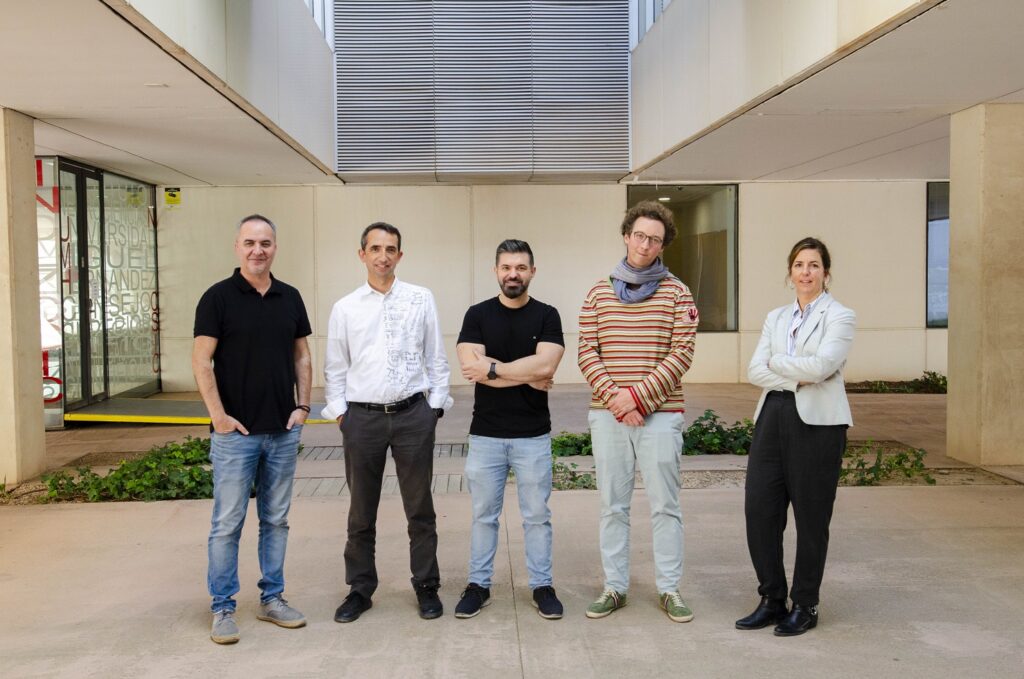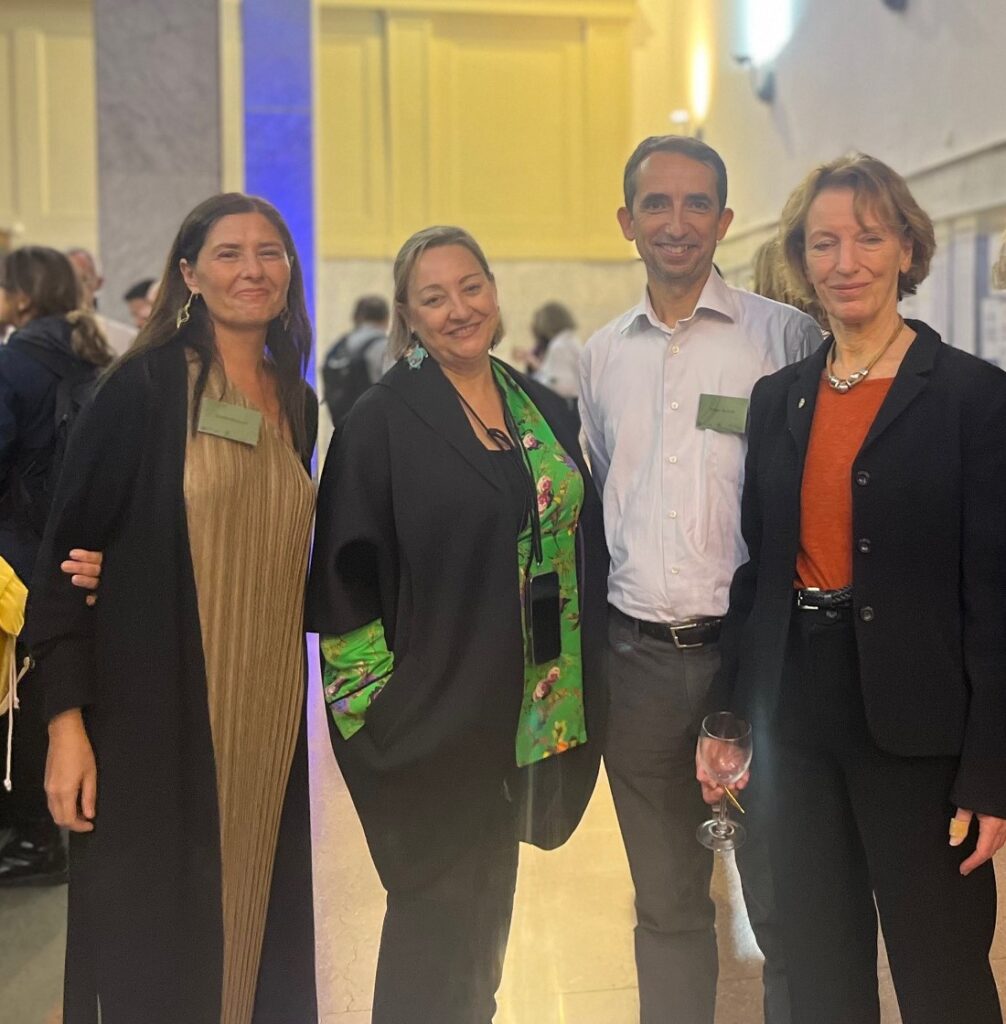Cutting-edge research done in Alicante
20 de November de 2023
- The evolution of human rationality, the role of the cerebellum, motivated behaviors, the formation of sensory circuits, or cortical folding, are issues in which the Institute for Neurosciences (IN) carries out cutting-edge research thanks to funding from the European Research Council (ERC).
- The IN has received 12 projects since the creation of this European funding agency in 2007.
The Institute for Neurosciences (IN), a joint center of the Spanish National Research Council (CSIC) and the Miguel Hernández University (UMH) of Elche, is the largest publicly funded center dedicated to brain and nervous system research, both in normal and pathological conditions in Spain. The researchers that compose it have proven to be successful in their participation in national, international, public, and private competitive calls, which allows them to develop cutting-edge research. Fine examples of this are the five projects funded by the European Research Council (ERC) that are currently being developed.
XSCAPE: The evolution of human rationality
The researcher Luis Miguel Martínez Otero, who directs The Visual Analogy Laboratory at the IN, is part of the project XSCAPE ‘Material Minds: Exploring the Interactions between Predictive Brains, Cultural Artifacts, and Embodied Visual Search’, awarded in 2020 with a 10 million euros Synergy Grant. It is the most competitive and best-funded call in European science and allows leading research groups to bring together different skills, expertise, and resources to expand the frontiers of our knowledge.
To carry out this research, which will run until 2027 and involve 2.5 million euros for the IN, the team is contextualizing a wide spectrum of archaeological societies from different countries and historical and cultural conditions, to carry out predictive processing studies and mathematical modeling of the cognitive process. All this in order to carry out the largest experiment of active visual perception ever carried out in natural and social conditions, and thus obtain the keys that allow us to understand the fundamental principles that guide cognitive change based on materiality and the material world.
XSCAPE is coordinated by Professor Felipe Criado Boado from the Institute of Heritage Sciences in Santiago de Compostela (Incipit) and the laboratories of Andy Clark, from the University of Sussex (United Kingdom), and Johannes Müller, from the Institute of Prehistoric and Protohistoric Archeology at the University of Kiel (Germany) also participate.
So far, a Summer School and an Autumn School have already taken place, which brought together all the members of the project to lay the theoretical and methodological foundations of the project and finalize the laboratory preparations and work protocols. The experiments are currently being carried out, which aim to cover more than 40 case studies around the world.
CERCODE: the cerebellum in the development of the cerebral cortex
The cerebellum is a brain structure that plays a critical role in motor function but also plays an essential role in cognitive development and social behavior, functions mainly associated with the cerebral cortex. Based on the hypothesis that the cerebellum influences the correct development and functioning of the cerebral cortex through its long-distance connections, IN researcher Juan Antonio Moreno Bravo was awarded in 2020 with a 1,5 million euros Starting Grant.
This funding allowed him to establish his own laboratory at the IN and, since then, the Development, Wiring and Function of Cerebellar Circuits laboratory studies how early alterations in the cerebellum could be responsible for the cognitive deficits of various neurodevelopmental pathologies, such as autism spectrum disorders. The long-term objective of the CERCODE project is to understand the contribution of the cerebellum to cognitive processes, both in normal development and in pathological conditions, and to try to transfer this knowledge to the clinical setting.
To carry out this research, the laboratory led by Moreno Bravo is generating animal models that allow altering the cerebellar circuits in order to analyze the impact on the global function of the brain. These mice try to mimic the lesions that can occur in the cerebellum of premature children who, in a high percentage, end up being diagnosed with an autism spectrum disorder.
 Photo: Researchers from the Institute for Neurosciences who lead active ERC projects: Luis M. Martínez Otero, Víctor Borrell Franco, Juan Antonio Moreno Bravo, Félix Leroy and Guillermina López Bendito.
Photo: Researchers from the Institute for Neurosciences who lead active ERC projects: Luis M. Martínez Otero, Víctor Borrell Franco, Juan Antonio Moreno Bravo, Félix Leroy and Guillermina López Bendito.
MotivatedBehaviors: neural bases of motivated behaviors
Another researcher from the Institute for Neurosciences who received a Starting Grant in 2020 is Félix Leroy who, thanks to funding of 1.7 million euros, established his laboratory Cognition and social interactions. Its objective is to study the role of the lateral septal nucleus in the regulation of motivated behaviors such as the search for comfort, security, food or socialization.
The project MotivatedBehaviors focuses on understanding how the cerebral cortex can regulate the activity of the different hypothalamic nuclei that control basic behaviors. Leroy explains that the cortex is involved in various psychiatric disorders associated with altered social behaviors, such as schizophrenia, autism, or bipolar disorder. Therefore, understanding basic neural mechanisms and disease processes is essential to understanding how memories and decisions regulate low-level motivated behaviors.
Within the framework of this project, researchers at his laboratory have discovered a neural circuit suppresses social interaction with familiar individuals and promotes interactions with novel ones. It is a group of neurons in the prefrontal cortex, characterized by the expression of the neuropeptide corticotropin-releasing hormone (CRH), project to the region of the lateral septum (LS).
These results, which describe for the first time a mechanism linking social memory with social novelty preference in mice, were recently published in Cell and could lead to the development of novel drugs for people suffering from social anxiety disorders such as avoidant personality or separation anxiety disorders.
SpontSense: formation of sensory circuits
The researcher Guillermina López-Bendito obtained a Starting Grant of 1.5 million euros in 2010 to develop the RECORTHA project and, later, in 2015, a Consolidator Grant of 2 million euros with which she carried out the SENSORTHALAMUS project. Now, thanks to an Advanced Grant of 2.5 million euros awarded in 2022, his group is developing the project 'SpontSense. Patterns of Spontaneous Activity in the Assembly and Rewiring of Functional Sensory Circuits’.
Its objective is to understand the principles of the development of sensory circuits and shed light on the possibility of long-term brain repair (plasticity) in sensory defects.
López-Bendito, who leads the laboratory Development, Plasticity and Reprogramming of Sensory Circuits, highlights that this project is important to identify possible windows of vulnerability, in which failures in specialization programs for sensory systems contribute to neurodevelopmental diseases correlated with poor sensory processing.
To carry out this research, the team will use a novel technology generated by her laboratory, with which it is possible to stimulate the sensory pathways in the mouse embryo and track the activity in the prenatal and immature cerebral cortices. Using this technology, researchers discovered that the sense of touch is activated in the brain before birth thanks to the spontaneous activity of the thalamus, which acts as a simulator of sensations that prepare this sense.
This project is based on the hypothesis that the different cortical sensory territories exhibit unique patterns of spontaneous activity that interact with specific genetic programs to functionally delimit the brain areas associated with each of the senses. SpontSense aims to address three key questions: identify spontaneous activity patterns and the genetic mechanisms that interact with them, find out how these patterns and genetic mechanisms interact for the segregation or specification of each sensory system and finally, change those patterns and see what impact they have on the sensory behavior of the adult individual.
UNFOLD: How is the cerebral cortex folded?
Cortical folding is a characteristic of the human brain that, when defective, leads to very serious learning and intellectual problems. Currently there is great interest in understanding the process of cortical folding, but, due to its great complexity, individual research groups have had to focus on studying specific aspects.
Thanks to the recent award of a Synergy Grant, endowed with 10.8 million euros, four laboratories will be able to share different skills and knowledge to address fields of research that have traditionally been ignored, under the coordination of the IN researcher Víctor Borrell. The UNFOLD project, which represents a total of 2.8 million euros for the IN, will address the issue of cortical folding from different points of view. The results of the experiments carried out will be framed in a global computational model to ask new questions and find answers.
Borrell, who leads the Neurogenesis and Cortical expansion laboratory and who in 2012 already obtained a Starting Grant to develop the CORTEXFOLDING project, with Kristian Franze's laboratories at the Institute of Medical Physics and Microtissue Engineering of the University of Erlangen-Nuremberg and at the Max-Planck-Zentrum für Physik und Medizin (Germany), Laurent Nguyen's laboratory at the GIGA Center of the University of Liège (Belgium), and Roberto Toro's laboratory at the Pasteur Institute (France), to develop this research until 2030.
This team of specialists in cell biology, brain evolution, physical sciences, and computational models will work across multiple species, from amphibians to large mammals, and generate complete atlases of all cell types, gene expression programs, and mechanical forces throughout brain development. Its objective is to analyze how all these elements interact with each other and give rise to cortical folding.

Photo: IN researchers Eloísa Herrera, Ángela Nieto, and Víctor Borrell with Maria Leptin, president of the ERC, during a meeting held at the CSIC last week.
In addition to those previously mentioned, it is also worth highlighting the projects WIRINGVISION, a Starting Grant obtained by researcher Eloísa Herrera in 2012, in which the genes involved in the formation of the binocular vision system that makes possible to see in three dimensions were discovered; and EMTASY, an Advanced Grant obtained by the researcher Ángela Nieto in 2013, which allowed us to expand our knowledge of the performance of the 'snail' genes. The project SYNAPDOMAIN, a Consolidator Grant of the researcher Beatriz Rico, and the proyject CORTICAL ASSEMBLY, an Advanced Grant of the researcher Óscar Marín Parra (both currently at King's College in London), complete a long list of 12 projects funded at the Institute for Neurosciences by the ERC since this European funding agency was established in 2007.
Source: Institute for Neurosciences CSIC-UMH (in.comunicacion@umh.es)

 Español
Español